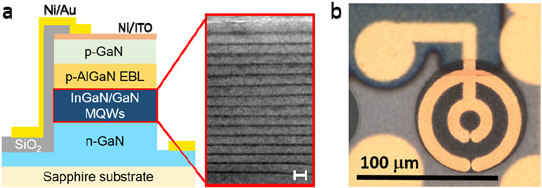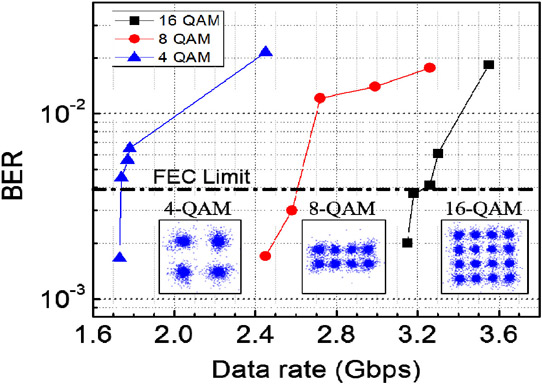- News
22 February 2018
III-nitride microphotodetector for visible light communication
King Abdullah University of Science and Technology (KAUST) in Saudi Arabia claims a record 3.2 gigabit per second (Gbps) data-rate performance for visible light communications (VLC) at 405nm wavelength [Kang-Ting Ho et al, Optics Express, vol26, p3037, 2018]. The orthogonal-frequency division mulltiplex (OFDM) system used an indium gallium nitride multiple quantum well microphotodetector (μPD) receiver and laser diode source with quadrature amplitude modulation (QAM) coding.
The researchers want to address the bandwidth and data security challenges for future high-speed mobile Internet, smart traffic, and Internet of Things (IoT). Bandgap limitations make the receiver portion of VLC systems particularly challenging.

Figure 1: (a) Schematic of InGaN/GaN MQW μPD and transmission electron microscope image showing 15-pairs of 3nm InGaN/13.5nm GaN (scale bar 20nm). (b) Optical microscope image of μPD with diameter of 80μm.
The μPDs used a multiple quantum well with 15-period InGaN/GaN structure grown on c-plane sapphire by metal-organic chemical vapor deposition (MOCVD) – see Figure 1. The aluminium gallium nitride electron-blocking layer (p-AlGaN EBL) was 100nm and the p-GaN was 150nm.
The μPD fabrication included an annealed 5nm/250nm nickel/indium tin oxide (Ni/ITO) transparent contact, 200nm silicon dioxide (SiO2) electrical isolation, and 10nm/1μm nickel/gold (Ni/Au) contacts.
The device demonstrated wavelength selectivity with -3V reverse bias between 374nm and 408nm – a passband full-width at half-maximum (FWHM) of 34nm. Peak response was 70.7mA/W at 392nm wavelength. The dark current was 37.4pA. The -3V reverse bias gave the optimal performance in terms of dark current and -3dB cut-off modulation bandwidth for 405nm radiation from a laser diode (71.5MHz).
An OFDM setup consisting of a 405nm laser diode and the μPD managed 16-QAM with a bit-error rate (BER) of 3.7x10-7 with 853MHz frequency response. This corresponds to a 3.2Gbps data-rate transmission (Figure 2). With a 7% overhead for forward-error correction (FEC), this is reduced slightly to 2.96Gbps for error-free transmission.

Figure 2: BER versus data rate of VLC link with different OFDM QAM order. Inset: corresponding constellation diagrams at 4-QAM, 8-QAM, and 16-QAM.
The researchers comment: “Our work features the record high data rate of VLC link using InGaN μPDs as receiver, which is the first demonstration of such system. In addition, compared with the prior reported results, our device was operated at lower bias voltage, and the carrier lifetime was shorter for high-speed modulation.”
KAUST Visible light communications Orthogonal-frequency division mulltiplex InGaN Quantum well microphotodetector
https://doi.org/10.1364/OE.26.003037
The author Mike Cooke is a freelance technology journalist who has worked in the semiconductor and advanced technology sectors since 1997.


